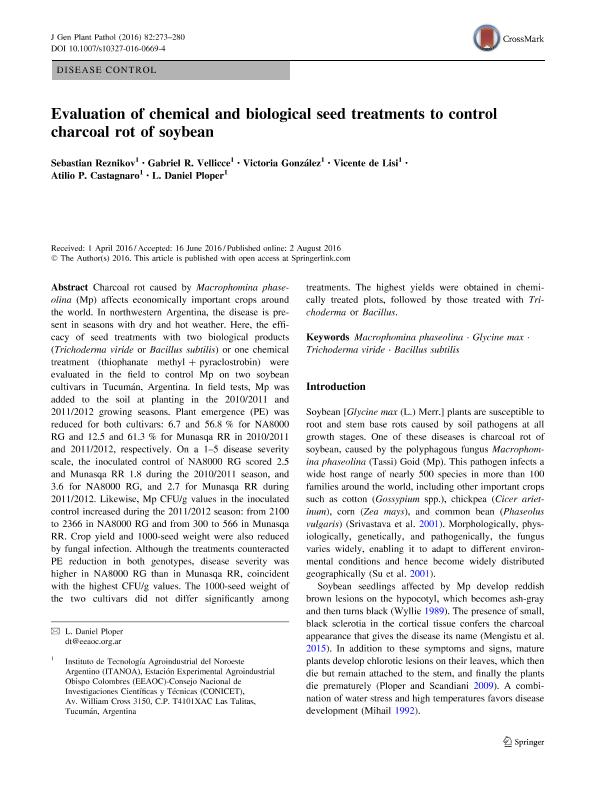Artículo
Evaluation of chemical and biological seed treatments to control charcoal rot of soybean
Reznikov, Sebastian ; Vellicce, Gabriel Ricardo; González, Victoria; de Lisi, Vicente; Castagnaro, Atilio Pedro
; Vellicce, Gabriel Ricardo; González, Victoria; de Lisi, Vicente; Castagnaro, Atilio Pedro ; Ploper, Leonardo Daniel
; Ploper, Leonardo Daniel
 ; Vellicce, Gabriel Ricardo; González, Victoria; de Lisi, Vicente; Castagnaro, Atilio Pedro
; Vellicce, Gabriel Ricardo; González, Victoria; de Lisi, Vicente; Castagnaro, Atilio Pedro ; Ploper, Leonardo Daniel
; Ploper, Leonardo Daniel
Fecha de publicación:
09/2016
Editorial:
Springer Tokyo
Revista:
Journal Of General Plant Pathology
ISSN:
1345-2630
Idioma:
Inglés
Tipo de recurso:
Artículo publicado
Clasificación temática:
Resumen
Charcoal rot caused by Macrophomina phaseolina (Mp) affects economically important crops around the world. In northwestern Argentina, the disease is present in seasons with dry and hot weather. Here, the efficacy of seed treatments with two biological products (Trichodermaviride or Bacillus subtilis) or one chemical treatment (thiophanate methyl + pyraclostrobin) were evaluated in the field to control Mp on two soybean cultivars in Tucumán, Argentina. In field tests, Mp was added to the soil at planting in the 2010/2011 and 2011/2012 growing seasons. Plant emergence (PE) was reduced for both cultivars: 6.7 and 56.8 % for NA8000 RG and 12.5 and 61.3 % for Munasqa RR in 2010/2011 and 2011/2012, respectively. On a 1–5 disease severity scale, the inoculated control of NA8000 RG scored 2.5 and Munasqa RR 1.8 during the 2010/2011 season, and 3.6 for NA8000 RG, and 2.7 for Munasqa RR during 2011/2012. Likewise, Mp CFU/g values in the inoculated control increased during the 2011/2012 season: from 2100 to 2366 in NA8000 RG and from 300 to 566 in Munasqa RR. Crop yield and 1000-seed weight were also reduced by fungal infection. Although the treatments counteracted PE reduction in both genotypes, disease severity was higher in NA8000 RG than in Munasqa RR, coincident with the highest CFU/g values. The 1000-seed weight of the two cultivars did not differ significantly among treatments. The highest yields were obtained in chemically treated plots, followed by those treated with Trichoderma or Bacillus.
Palabras clave:
Bacillussubtilis
,
Glycine Max
,
Macrophomina Phaseolina
,
Trichodermaviride
Archivos asociados
Licencia
Identificadores
Colecciones
Articulos(ITA-NOA)
Articulos de INST. DE TECNOLOG. AGROINDUST. DEL NOROESTE ARGENTINO
Articulos de INST. DE TECNOLOG. AGROINDUST. DEL NOROESTE ARGENTINO
Citación
Reznikov, Sebastian; Vellicce, Gabriel Ricardo; González, Victoria; de Lisi, Vicente; Castagnaro, Atilio Pedro; et al.; Evaluation of chemical and biological seed treatments to control charcoal rot of soybean; Springer Tokyo; Journal Of General Plant Pathology; 82; 5; 9-2016; 273-280
Compartir
Altmétricas



